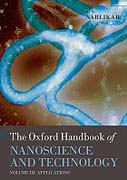
Oxford handbook of nanoscience and technology Vol. 3 Applications
Narlikar, A.V.
Fu, Y.
This is an agenda-setting and high-profile book that presents an authoritative and cutting-edge analysis of nanoscience and technology. The Oxford Handbookof Nanoscience and Technology provides a comprehensive and accessible overview of the major achievements in different aspects of this field. The Handbook comprises 3 volumes, structured thematically, with 25 chapters each. Volume I presents fundamental issues of basic physics, chemistry, biochemistry, tribology etc. of nanomaterials. Volume II focuses on the progress made with host of nanomaterials including DNA and protein based nanostructures. Volume III highlights engineering and related developments, with a focus on frontal applicationareas. All chapters are written by noted international experts in the field. The book should be useful for final year undergraduates specializing in the field. It should prove indispensable to graduate students, and serious researchers from academic and industrial sectors working in the field of Nanoscience and Technology from different disciplines including Physics, Chemistry, Biochemistry, Biotechnology, Medicine, Materials Science, Metallurgy, Ceramics, Information Technology as well as Electrical, Electronic and Computational Engineering. INDICE: 1: K. Shiraishi and T. Nakayama: Role of Computatioanal Sciences in Si-Nano Technologies and Devices 2: D. V. Melnikov, J. Kim, L.-X. Zhang, andJ.-P. Leburton: Few-Electron Quantum Dot Spintronics 3: J.-Ph. Ansermet: Spintronics with Metallic Nanowires 4: W. Wernsdorfer: Molecular Nanomagnets: Towards Molecular Spintronics 5: D.J. Paul: Si/SiGe Heterostructures in Nanoelectronics 6: Dimitri D. Vvedensky: Quantum Dots: Self-Organized and Self-Limiting Assembly 7: E. Towe and D. Pal: Intersublevel Quantum-Dot Infrared Photodetectors 8: T. Hasegawa, K. Terabe, T. Sakamoto, and M. Aono: Nanoionics and its Device Applications 9: D. Vuillaume: Molecular Electronics Based on Self-Assembled Monolayers 10: S. Hong , Y.-K. Kwon, J.S. Ha, N.-K. Lee, B. Kim, and M. Sung: Self-Assembly Strategy of Nanomanufacturing of Hybrid Devices 11: T. Kyotani and H. Orikasa: Templated Carbon Nanotubes and the Use of their Cavities forNanomaterial Synthesis 12: R. T. Vang, S. Wendt, and F. Besenbacher: Nanocatalysis 13: A. Burke, D. Carroll, F. M. Torti, and S.V. Torti: Bi-Functional Nanomaterials for the Imaging and Treatment of Cancer 14: D. Maysinger, P. Kujawa, and J. Lovric: Nanoparticles in Medicine 15: Anil K. Kodali and Rohit Bhargava: Nanostructured Probes to Enhance Optical and Vibrational Spectroscopic Imaging for Biomedical Applications 16: P.P. Pompa and R. Rinaldi: Protein Based Nano-Devices 17: P. Zrazhevskiy and X. Gao: Bioconjugated Quantum Dots for Tumor Molecular Imaging and Profiling 18: C.-W. Lin, N.-F. Chiu, and C.-C. Chang:Modulation Design of Plasmonics for Diagnostic and Drug Screening 19: Sigen Wang, Otto Zhou, and Sha Chang: Carbon Nanotube Field Emission Electron and X-Ray Technology for Medical Research and Clinical Applications 20: Yufeng Zhao, Yong-Hyun Kim, S. B. Zhang, and Michael J. Heben: Theory of Hydrogen Storage in Nanoscale Materials 21: Vu Thien Binh: Electron Cold Sources: NanotechnologyContribution to Field Emitters 22: X.Y. Kong, Y.C. Wang, X. F. Fan, G. F. Guo, L. M. Tong, Z.F. Liu: Free-Standing Grid-Like Nanostructures Assembled into 3-D Open Architectures for Photovoltaic Devices 23: C.L. McGuiness, R.K. Smith, M.E. Anderson, P. S. Weiss, and D. L. Allara: Nanolithography Using Molecular Films and Processing 24: M. H. Hong: Laser Applications in Nanotechnology 25: K. Thomas, N. Monteiro-Riviere, D. Warheit, and N. Savage: Evaluating the Risks Associated with Nanomaterials
- ISBN: 978-0-19-953306-0
- Editorial: Oxford University
- Encuadernacion: Cartoné
- Páginas: 910
- Fecha Publicación: 11/02/2010
- Nº Volúmenes: 1
- Idioma: Inglés
